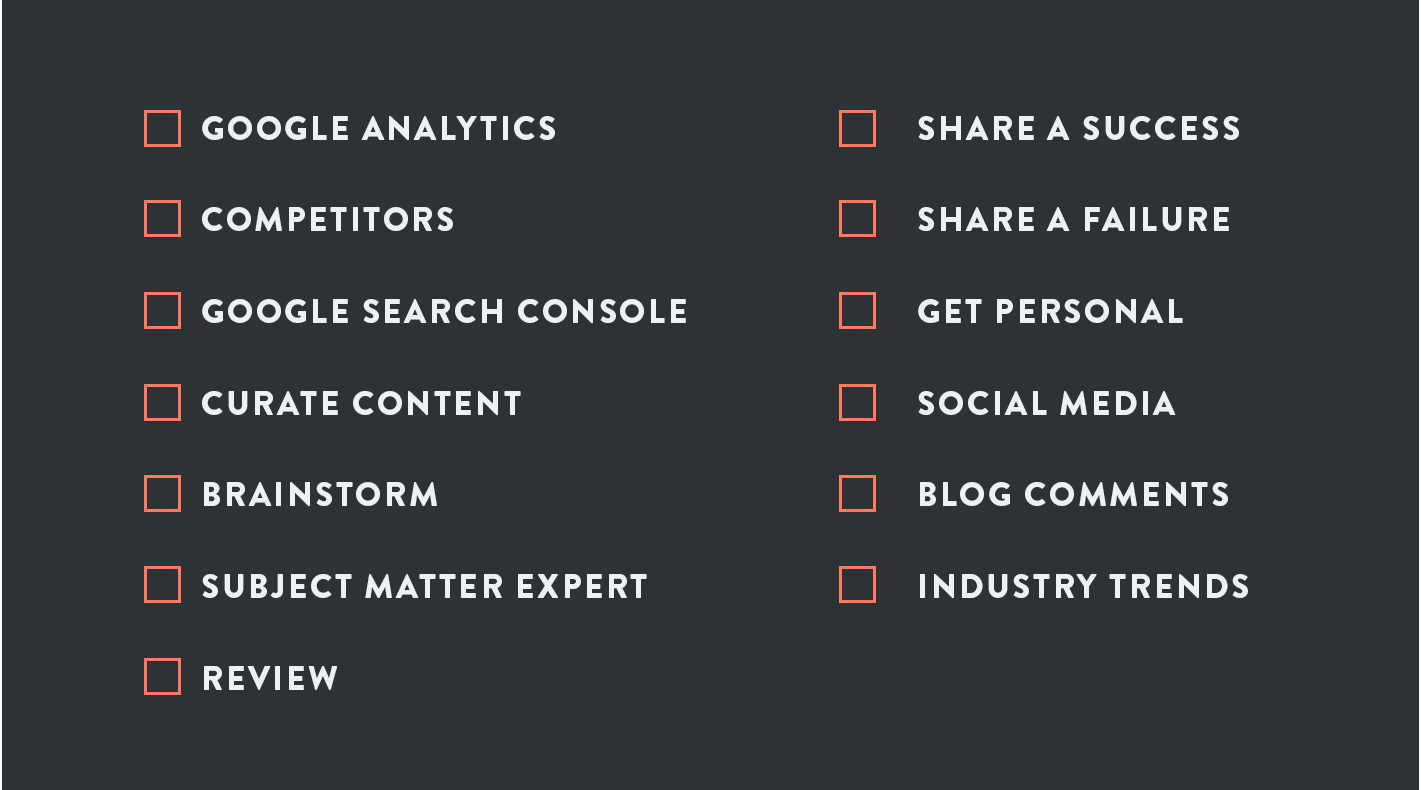HOW TO PRODUCE STRONG CONTENT (A CHECKLIST)
Reaching out to existing and potential customers can be like hitting a bullseye in a hurricane. Traditional advertising methods like television and radio spots just don’t have the same reach that they used to. After all, we’re pretty far past the “Mad Men” era of marketing. Due to the vastness of the digital realm, digital advertising can be difficult to streamline, but strong relevant content is one marketing tactic that seems to be hitting home with consumers. Don’t minimize your efforts in the digital realm just because isn’t easy.
Just how effective is content? Well, 61% of consumers report they’ve bought something recommended by blogs they read — instead of blindly trusting an ad they saw. Researchers have found that content generates three times the leads of traditional marketing programs — and at 62% less cost. Content has also been proven to elevate a company’s reputation and make them seem more trustworthy.
Using content in your marketing strategy seems like a no-brainer. Creating high-performing content is something a lot of companies seem to be missing. Read on for content generation ideas and tips for producing strong content.
HOW TO GENERATE CONTENT
Strong content needs to accomplish three goals:
Connect with your customers and target audience
Capture and hold the interest of your readers
Position your company as an industry/thought leader
These goals might sound simple, but finding topics that accomplish all three can, and will be, one of the most frustrating aspects of creating content. The topics your company considers important are not always the topics that will resonate with readers. Unless your potential customers are submitting content topics they’d like you to target, coming up with content ideas that will resonate can be overwhelming.
If you don’t know where to start in coming up with topics, it’s nearly guaranteed that running through this checklist will leave you with some relevant ideas.
CONTENT GENERATION CHECKLIST
Google Analytics
Analyze which of your pages has the most page views to better understand content prioritiesCompetitors
Do a dive into competitive sites to see what they’re writing about
Google Search Console
Use the Search Console to see which search queries you are already ranking for
Curate Content
Compile a list of your favorite content from other sources and link out to them
Brainstorm
Hold a brainstorming session with your team members and crowdsource topic ideas
Subject matter expert
Interview an expert in your industry and turn it into a post or use it for topic conceptualizationReview
Pick a product or service and discuss the pros and cons
Share a Success
Write about a recent win and how you were able to achieve it from a learning perspective
Share a Failure
Write a recent challenge and what you’ve learned from it
Get Personal
Share a personal touch or a personal story to bring connection to your content
Social Media
Check out industry groups on social media to see what problems others might be having or what content is resonating
Blog Comments
Mine comments on your own blog as well as other well-read industry blogs for more insight into your target audience
Industry trends
From products and trends to technology and studies, there’s something in the industry you can offer an opinion on
HOW TO ORGANIZE YOUR CONTENT
Coming up with topic ideas is the first challenge, but the second is how to best organize your content. There’s no one-size-fits-all answer for what’s right, so you’ll have to do some self-reflection to determine the best course for you and your company. There are, however, some guidelines to keep in mind while you’re creating the organization plan that works for you.
Content Organization Principle #1: Plan a Content Calendar
It would be fantastic if we could wake up every day and remember everything we need to do at the exact right time and never forget anything, right? But that’s not reality. In order to stay organized and be successful at producing content, you have to have a calendar. Again, every company’s calendar looks different, but you need to ask yourself the following questions to properly plan:
How frequently will we publish?
Daily? Weekly? Monthly? Somewhere in between?
What type of content will we need to produce?
Blogs aren’t the only type of content out there — not even the only type of written content. Consider other content types in your calendar, such as videos, long-form content such as whitepapers, infographics, etc.
What’s the process for approval?
How many people will need to see this content before it’s published? If it’s more than one (and it probably should be), you’ll need to plan out writing, editing and reviewing deadlines.
Content Organization Principle #2: Include Evergreen Content
Timely, trendy topics and references are great to include but can become dated very quickly. Internet time moves a lot faster than you realize. “Evergreen” content is content that is relevant at any time of year. When you’re creating a content calendar, peppering in some evergreen content is a good principle no matter your company’s industry.
Content Organization Principle #3: Create Content in Batches
Is your company’s business seasonal? Are some parts of the year busier than others? In order to produce content regularly, you need to produce it in batches throughout the year and then distribute when appropriate. Internally, you can categorize topics and then decide when would be the best time of year to publish them.
Content Organization Principle #4: Draft a Promotion Plan
Joseph Juran’s “Pareto principle” states that 80% of consequences come from 20% of the causes. Translating the Pareto principle to content production means 20% of your time should be spent on content creation and 80% on promotion.
You’ve spent a lot of time on creating this content up to this point, so it would be a shame if no one ever saw it. Almost no company can publish content and see high performance numbers without taking steps to distribute it.
Promoting your content is important, so take time to consider exactly how — and when and why — each piece will be distributed and amplified.
Content Organization Principle #5: Measure Your Success
Remember when you were determining topics at the beginning of this blog? You’ll have to do that more than once, and measuring what’s working and not working is vital to the constant refining of your content ideation process. Some analytics you should be measuring that will give you valuable insight into how well your content is resonating include:
Number of page views
Top content views
Time spent on page
Bounce rate
CONTENT PRODUCTION IN A POST-PANDEMIC WORLD
The COVID-19 pandemic changed the ways we’ve done a lot of things, and content production has had to evolve as a result. While the content generation process hasn’t changed that much, here are some considerations to keep in mind in this new era that will help you better connect with your audience.
1. Show empathy
No matter your industry, you may need to re-evaluate your customer’s needs and pain points — even if they’ve been the same over the last several decades. Place yourselves in your customer’s shoes and consider what experiences they’ve had over the last year.
Produce content from a place of understanding, not one that’s tone-deaf. This may mean some of your content should be more light-hearted or “feel-good.” It’s been a tough year.
2. Stay flexible
Change has been the only constant during the pandemic, and companies have to remain agile in order to keep up. Staying on top of current news and trends may mean your content calendar needs to shift or you need to eliminate some content that’s no longer relevant (or could be perceived as negative).
3. Allow customers to come to you
Many companies are opting for less aggressive sales teams and strategies during the pandemic, as pushy, promotional messages are resonating less and less. Pushy, in-your-face content is resonating less and less. Messaging should be aimed at solving problems rather than promoting products. Thought leadership content and other types that add value rather than pitch a sale are more effective.
4. Build community
Everyone knows businesses have been struggling during the pandemic, and so have individuals. Not seeing customers face-to-face can leave many businesses feeling out of touch.
Instead of traditional methods, companies should work to build a community through digital tools. Email newsletters that speak frankly and openly about struggles and successes are some that are currently resonating. Virtual events can help build a sense of community around a brand.
PRODUCING CONTENT WITH FARMORE
At Farmore, we partner with our clients to collaborate on content production that genuinely captures their brand personality. We pride ourselves on our strong attention to detail and clear communication, and every single piece of content we create is tailor-made for our clients, and customized to meet their specific needs. Check out our portfolio to see some of the custom content we’ve created.





